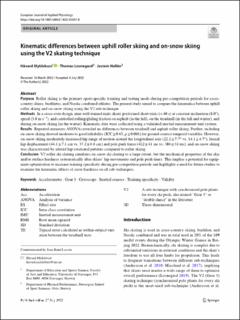| dc.contributor.author | Myklebust, Håvard | |
| dc.contributor.author | Losnegard, Thomas Johansen | |
| dc.contributor.author | Hallén, Jostein | |
| dc.date.accessioned | 2022-11-29T17:15:31Z | |
| dc.date.available | 2022-11-29T17:15:31Z | |
| dc.date.created | 2022-09-23T09:46:09Z | |
| dc.date.issued | 2022 | |
| dc.identifier.citation | European Journal of Applied Physiology. 2022, 122(11), Side 2355-2365. | en_US |
| dc.identifier.issn | 1439-6319 | |
| dc.identifier.uri | https://hdl.handle.net/11250/3034843 | |
| dc.description | This article is licensed under a Creative Commons Attribution 4.0 International License, which permits use, sharing, adaptation, distribution and reproduction in any medium or format, as long as you give appropriate credit to the original author(s) and the source, provide a link to the Creative Commons licence, and indicate if changes were made. The images or other third party material in this article are included in the article's Creative Commons licence, unless indicated otherwise in a credit line to the material. If material is not included in the article's Creative Commons licence and your intended use is not permitted by statutory regulation or exceeds the permitted use, you will need to obtain permission directly from the copyright holder. | en_US |
| dc.description.abstract | Purpose: Roller skiing is the primary sport-specific training and testing mode during pre-competition periods for cross-country skiers, biathletes, and Nordic combined athletes. The present study aimed to compare the kinematics between uphill roller skiing and on-snow skiing using the V2 sub-technique.
Methods: In a cross-over design, nine well-trained male skiers performed short trials (< 40 s) at constant inclination (8.0°), speed (3.0 m‧s−1), and controlled rolling/gliding friction on asphalt (in the fall), on the treadmill (in the fall and winter), and during on-snow skiing (in the winter). Kinematic data were collected using a validated inertial measurement unit system.
Results: Repeated-measures ANOVAs revealed no differences between treadmill and asphalt roller skiing. Further, including on-snow skiing showed moderate to good reliability (ICC ≥ 0.63, p ≤ 0.001) for ground-contact temporal variables. However, on-snow skiing moderately increased hip range of motion around the longitudinal axis (22.2 ± 7.7° vs. 14.1 ± 4.7°), lateral hip displacement (44.1 ± 7.1 cm vs. 37.2 ± 6.6 cm) and pole push times (422 ± 41 ms vs. 386 ± 31 ms), and on-snow skiing was characterized by altered hip rotational patterns compared to roller skiing.
Conclusion: V2 roller ski skating simulates on-snow ski skating to a large extent, but the mechanical properties of the skis and/or surface hardness systematically alter skiers’ hip movements and pole push times. This implies a potential for equipment optimization to increase training specificity during pre-competition periods and highlights a need for future studies to examine the kinematic effects of snow hardness on all sub-techniques. | en_US |
| dc.language.iso | eng | en_US |
| dc.subject | accelerometer | en_US |
| dc.subject | gear 3 | en_US |
| dc.subject | gyroscope | en_US |
| dc.subject | inertial sensors | en_US |
| dc.subject | training specificity | en_US |
| dc.subject | validity | en_US |
| dc.title | Kinematic differences between uphill roller skiing and on-snow skiing using the V2 skating technique | en_US |
| dc.type | Peer reviewed | en_US |
| dc.type | Journal article | en_US |
| dc.description.version | publishedVersion | en_US |
| dc.rights.holder | © 2022 The Authors | en_US |
| dc.source.pagenumber | 2355-2365 | en_US |
| dc.source.volume | 122 | en_US |
| dc.source.journal | European Journal of Applied Physiology | en_US |
| dc.source.issue | 11 | en_US |
| dc.identifier.doi | 10.1007/s00421-022-05007-0 | |
| dc.identifier.cristin | 2054640 | |
| dc.description.localcode | Institutt for fysisk prestasjonsevne / Department of Physical Performance | en_US |
| cristin.ispublished | true | |
| cristin.fulltext | original | |
| cristin.qualitycode | 1 | |
